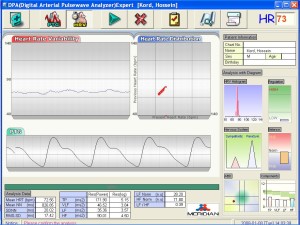Heart Rate Variability (Stress) Evaluation:

This is the second part of the Comprehensive Cardiovascular evaluation. HRV reflects heart’s ability to adapt to changing circumstances by detecting and quickly responding to unpredictable events.
Low HRV has been shown in numerous studies to be related to a higher mortality rate in both healthy and unhealthy subjects.
There are two methods for evaluating HRV, (Time Domain and Frequency Domain) and both of them are used here.The following markers will be evaluated and calculated for Heart Rate Variability measurement:
Time Domain Method:
- SDNN: Standard Deviation, Normal to Normal heart beat. Good estimate of ANS status
- RM-SSD: Good estimate of parasympathetic regulation of heart (PNS)
- Mean HRT: Average heart rate over 5 minutes
- Mean NN: Average time between two regular heart beats (normal to normal)
Frequency Domain Analysis (Spectral Analysis):
- Total Power (TP): Overall “vitality” in the nervous system across all frequencies
- Very Low Frequency (VLF)
- Low Frequency (LF): Reflects both sympathetic and parasympathetic activities
- High Frequency (HF): Reflects parasympathetic (valal) tone and fluctuations caused by respiration known as respiratory sinus arrhythmia.
- LF / HF Ratio: Indicates overall balance between sympathetic and parasympathetic system.
- Sympathetic Nervous System Balance (SNS:PNS)
- Autonomic Balance Diagram (ABD): Most important part of HRV evaluation. Indicating active status of autonomic nervous system.
